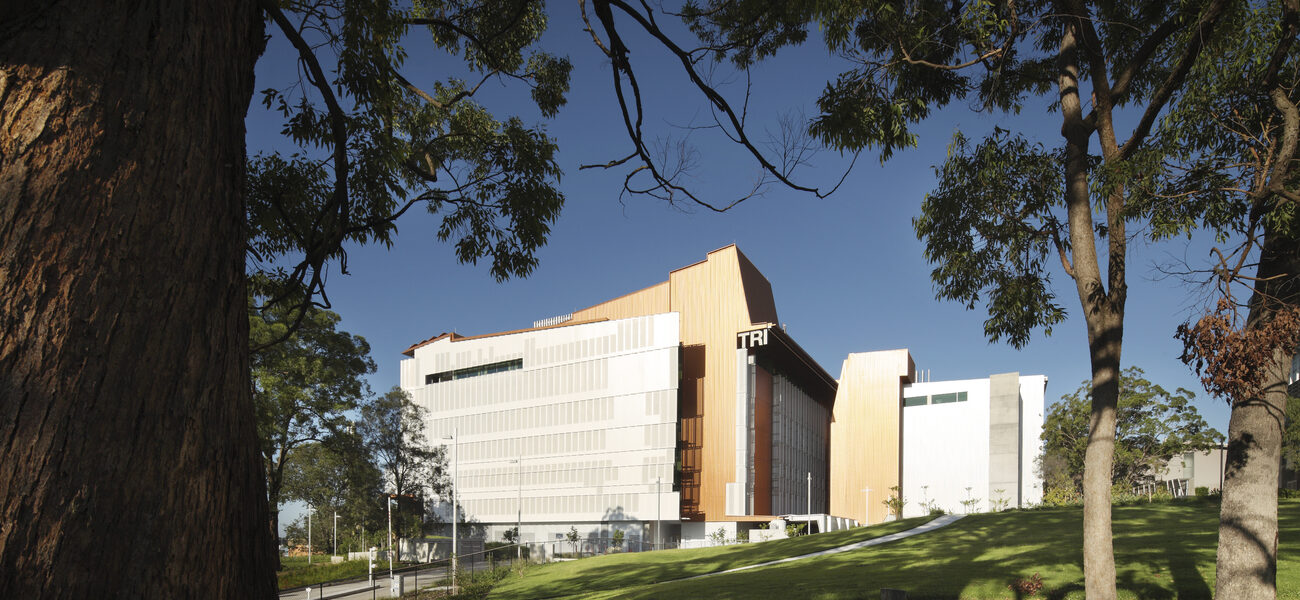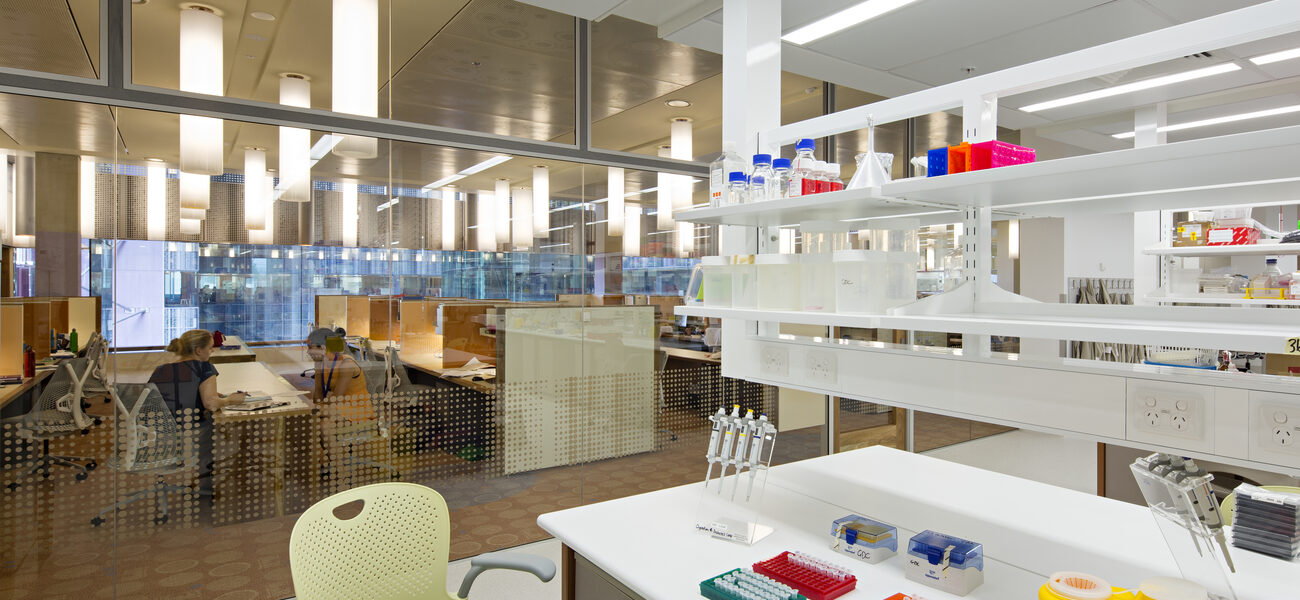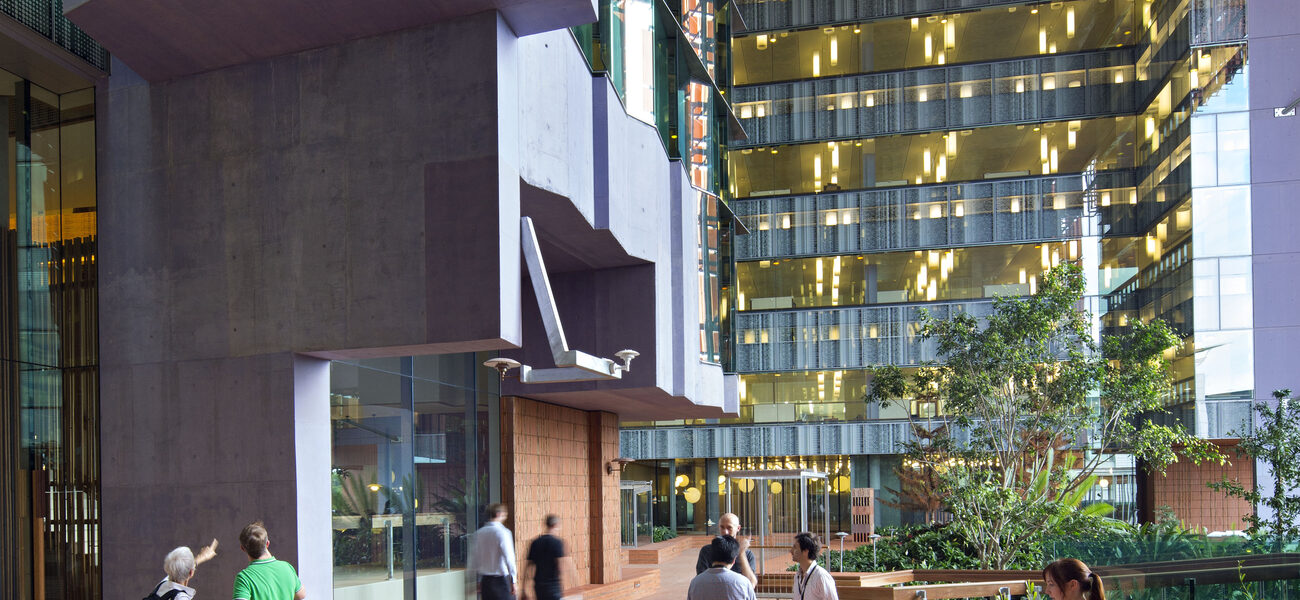The recently opened Translational Research Institute (TRI) in Brisbane, Australia, combines four major research institutes into a single medical and biopharmaceutical research facility where new treatments can be developed, manufactured, and clinically tested in one location, greatly shortening the time between discovery and application. Located on the Princess Alexandra Hospital campus, Queensland’s second-largest hospital, the $340 million, seven-story building contains advanced research labs, cleanrooms, and commercial space, as well as a state-of-the-art vivarium and support space for 600-plus researchers.
An adjacent 70,000-sf biopharmaceutical manufacturing facility—run by DSM Biologics—will provide the additional production capacity to take new discoveries for fighting cancer and other chronic diseases from the lab all the way to full commercialization scale on site.
There were two main drivers for creating this one-of-a-kind facility: to bridge the gap between discovery and real-world clinical application and to share expensive core equipment among multiple institutions working toward similar goals.
“There’s too much basic science being done in Australia that isn’t making it into the clinic,” says Professor Ian Frazer, director of research and CEO at TRI, and one of the original developers of the cervical cancer vaccine. “According to the National Health and Medical Research Council, less than a third of successful basic research undertaken in Australia is translated into practice. TRI will help reverse that trend.”
While the four major research organizations—the University of Queensland Diamantina Institute, Queensland University of Technology Institute for Health and Biomedical Innovation, Princess Alexandra Hospital Centre for Health Research, and Mater Research—share a single set of core equipment, they each retain their individual identity.
“There has been an expensive change over the last 15 years in the way biomedical research is done,” says Frazer. “Core equipment that used to cost hundreds of thousands of dollars now costs tens of millions. This means that cores have to be running 24/7 and be shared between as many people as possible to be efficient in terms of cost.”
By sharing capital-intensive core facilities, TRI allows a larger number of researchers to conduct investigations into a wide range of areas including cancers, diabetes, obesity, and liver disease, as well as diseases such as HIV and malaria. Economies of scale mean that equipment can be updated every two years, instead of every five to six years.
Biopharmaceutical Future
According to Frazer, more than half of all new drugs licensed today are biopharmaceuticals—proteins manufactured to match corresponding human proteins that are delivered in therapeutic doses—as opposed to more traditional pharmaceuticals, which are small drug molecules.
TRI’s labs support research in genomics, proteomics, and bioinformatics, among other things, while an onsite GMP manufacturing facility has the capacity to produce batches of mammalian biopharmaceuticals ranging from pilot sizes of 50 liters to full production scale of 2,000 liters. The manufacturing facility also uses a disposable lining system that reduces environmental impact and allows for contract manufacturing of different biopharmaceutical products.
“Once basic research indicates we’ve found something useful, we’ll actually be able to produce it and take it straight into the clinic,” says Frazer. “This is a proven model that is already being done. The building will just expedite the process by having everything in one place.”
Onsite Modeling and Testing of Diseases
TRI also features a vivarium, believed to be the largest such facility in the southern hemisphere. This provides a specialized population for modeling and testing cures for human disease states.
“The goal is to make a disease model as close to human disease as possible,” says Frazer. “Then treat the mouse just like you would treat a patient. We essentially have a full mouse hospital, with its own pharmacy, imaging suite, pathology, and doctors—all the same facilities that would be necessary to care for a human patient.”
This facility feeds into a health sciences center where Phase I and Phase II clinical trials can be conducted once a new therapy is proven successful in initial research.
“More than half of all the research group heads working in the building are also hospital appointees with clinical appointments,” says Frazer. “They work on establishing the pathophysiology of diseases using the latest tools for constructing animal models that reflect those diseases.”
Future Proof Flexibility
TRI uses a modular flexible layout that allows the building to maintain research and instructional flexibility. Utilities are suspended from the ceiling so modules can be easily redesigned to accommodate changing goals and teams.
“We wanted to make sure we could readily meet the needs of future generations of scientists,” says Frazer.
Organized around a large central atrium with a spiral staircase, the building contains lab modules, commercial modules, and core facility modules, with the core equipment available to all occupants in the building.
“The core facility modules are not specific for individual institutes. They are specific to areas of research,” says Frazer. “Since they are integrated throughout the building, it’s an interesting challenge working out what everyone is doing. It’s not a research hotel, but it runs as one in terms of the logistics, because we have to charge back shareholders based on what they spend.”
Lab modules feature an emphasis on open transparency with an extensive use of glass. There are also instructional labs, classroom, and break areas, as well as a large auditorium and public interaction areas.
“The medical school occupies half of one floor to ensure that there is ongoing interaction between the medical students and the scientists working in the building,” says Frazer.
Maximize Research and Minimize Cost
While researchers are enthusiastic about coming together in a facility like this, Frazer explains that institute directors and boards are naturally cautious about the impact on institution identity. Consequently, getting researchers engaged in integration from the beginning was critical to the success of the Institute.
“Administrators tend to see costs and problems, whereas the researchers doing the work see opportunities,” says Frazer. “They drive the process of integration because they know what will give them the best research opportunities.”
To help drive collaboration, joint research meetings were held with key researchers from each of the respective institutes starting two years before TRI opened.
“We wanted to make sure that we were already working together when we finally came together in the same location,” says Frazer.
While sharing core facilities and combining the efforts of multiple institutions is a great way to maximize research while reducing costs, it is also a complicated undertaking with a host of logistical issues that require extensive planning and management.
“Bringing together four institutes to share core facilities is an inordinately complex business,” says Frazer. “You have four different sets of staff to organize, and they all get very nervous about how the whole thing is going to work out. But at the end of the day, it is just much cheaper to run.”
By Johnathon Allen
This report is based on a presentation by Professor Ian Frazer at the Tradeline 2012 Academic Medical and Health Science Centers conference.


